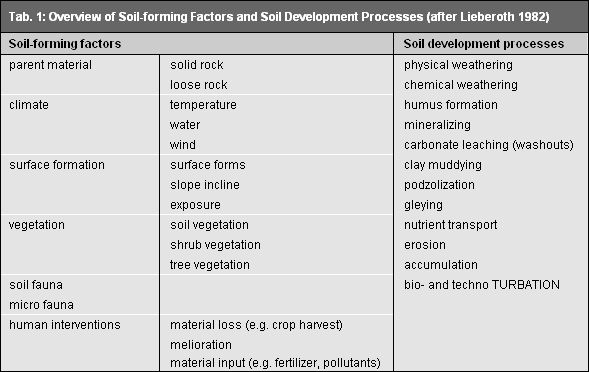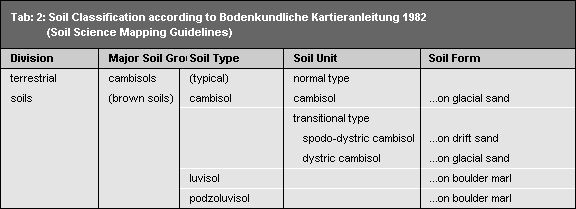Soil Types – Horizons
Soil types are seen as stages of soil development often encountered under certain environmental conditions. They unify soils with the same or similar profile structures (horizon layers), due to similar processes of material transformations and translocations.
The most frequent soil types in Berlin are mineral soils with less than 30 mass percent of organic substances. These soils are sometimes overlaid with organic horizons of varying thickness; H, L, or O horizons with more than 30 mass percent of organic substances, especially in forests.
Soil types of mineral soils are categorized into the following horizons:
mineral topsoil horizon – A horizon
mineral subsoil horizon – B horizon
mineral undersoil horizon – C horizon
The mineral topsoil A horizon is characterized by the accumulation of organic substances and/or a loss of mineral substance; washouts of clay, humic materials, iron oxides and aluminum oxides. Material-specific accumulation and translocation processes enable further divisions of the A horizon. This differentiation in horizon terminology is given with a lower case letter; e.g., Ah, h stands for humus; Al, l stands for clay lessivation (washout).
The mineral subsoil B horizon is characterized by the accumulation of materials washed out of the topsoil horizon, as well as weathering and transformational processes, e.g., brunification, formation of clay, etc. This produces colors and material compositions different than the parent rock. Further differentiation of the B horizon parallels the A horizon, e.g. Bv, v stands for brunification; Bt, t stands for clay illuviation (“wash in”).
The mineral undersoil C horizon is formed by the relatively unaltered parent rock underneath the soil.
Soils characterized by several material translocational or transformational processes have several A and/or B horizons in their soil profile.
The horizon sequence gives the horizon profile. The horizon profile is then used to differentiate soils into soil types.
Another factor in the formation of soil types is the groundwater level. The temporary or permanent action of groundwater on soils affects how terrestrial soils form gley characteristics, e.g. rust and bleached spots. The depth of gley characteristics is applied in the naming of soil types, such as cambisols (brown soils):
< 40 cm – eutric gleysol (brown gley soil)
40 – 80 cm – eutro-gleyic cambisol (gleyic brown soil)
80 – 130 cm – stagno-gleyed cambisol (gleyed brown soil).
Anthropogenic Alterations of the Soil
Anthropogenic alterations of the soil have increased with progressing use of technologies and the use of ever larger areas.
Today there are hardly any untouched soils with unaltered horizon structures. Soils are categorized as near-natural where horizon sequences remain largely unchanged in spite of human uses such as forest plantations. Soils are categorized as anthrosols (anthric, anthropogenic soils, soils influenced by humans) when the horizon sequence has been destroyed. It has proven extremely difficult to categorize soils into these two groups. The upper 20-30 cm of soils used for agriculture are usually mixed by plowing. Soils used for military training or for cemeteries can sometimes retain near-natural soils alternating in small areas with anthric soils. The degree of anthropogenic influence and/or the degree of destruction is difficult to estimate without soil studies. Another factor for the effect of use is whether area use was total or partial.
A developmental point of view sees soils as relatively “young” or “old”. Soils relatively unaffected by use have a developmental period of up to several thousand years. The primary development of soils in the Berlin area occured in the Holocene period, which began about 10,000 years ago. A favorable climate, and the quick spread of vegetation connected with it, caused a stronger formation of soils. Various soil-forming processes took place during the long developmental period, and these processes are reflected in the formation of typical horizons. The horizon sequences of these soil types are much more greatly differentiated than those of “younger” soils.
Soil does not reproduce and is not reproducible. The use of soil is often linked with alterations of the original ecological conditions and this can lead to serious endangerment to the functional abilities of soil or even to its existence.
The quantity of this natural resource is endangered by the progressive sealing of surfaces. Industrial, commercial, traffic, and residential uses of soil have greatly increased in recent years. Unsealed soils once used agriculturally are found at the edge of the city; these soils have largely near-natural structures. Building construction causes soils to be transported, mixed, and sealed over extensive areas.
The quality of soils is altered by pollutants. Soils are impaired by pollutant inputs from unregulated waste disposal, accidents, spills and leakages, improperly conducted storage depots, as well as emissions from industry, commerce, and traffic.
Pollutant inputs can directly and indirectly endanger all organisms, including humans. The primary danger is uptake of pollutants through the food chain, but attention must also be given to the direct oral uptake of soils, especially by small children.
Soil can only store a certain amount of pollutants. If soil storage capacity is exceeded, pollutants can pass through soils and enter groundwater.
These problems are more intense in metropolitan areas like Berlin: “area use”, the quantitative problem of sealing, and the qualitative problem of material loads on soils from old contaminated sites and other pollutant inputs.
The protection of the remaining near-natural soils is urgently necessary because soil does not reproduce; it cannot be manufactured, bred or grown. Strongly impaired soils can hardly ever be restored to their original quality.
Soil Protection
The discussion and considerations on soil protection at the federal and state government levels in West Germany first really got underway at the beginning of the 80’s. Soil protection was first anchored in law in the Federal Soil Protection Law of 1998. This law was supplemented by a Berlin law in 2004.
The goal of the Berlin Soil Protection Law is “to protect the soil as the basis of life for humans, animals, and plants; to avert damaging alterations and to take precautions against the origin of new ones”. Long-term effects to soil are to be avoided, and the natural functions of soil are to be protected.
A prerequisite for effective soil protection is knowledge about the condition of soils, as well as impairments in their quantity and quality. Information has been processed for years in Berlin about soil use, degree of sealing, and material load. This information is the basis for the evaluation of anthropogenic load on soils A Cadastre of impacts on soil were conducted, and a Map of Degree of Sealing, and a Map of Use were prepared.
The planning of soil protection measures and the consideration of soil protection concerns at individual planning levels require determinations of soil value, suitability, and sensitivity. Complete data about distribution of soils and their ecological characteristics must be available. The Map of Soils offers a basis for the derivation of ecological parameters that serve the evaluation of properties and functions of soils.


